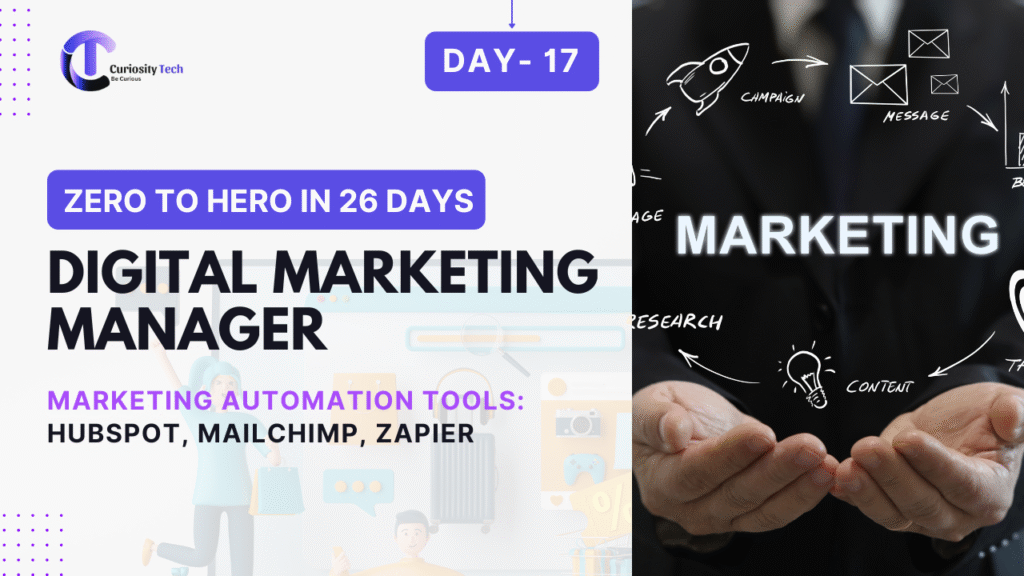Introduction
In 2025, marketing is no longer about working harder—it’s about working smarter with automation. From lead nurturing to email campaigns and CRM workflows, automation tools like HubSpot, Mailchimp, and Zapier are reshaping how businesses scale.
At CuriosityTech.in (Nagpur’s digital consulting hub), we’ve deployed automation frameworks for startups, SMEs, and large-scale enterprises. Let’s unpack these three tools in de
Why Automation Matters in 2025
● Saves Time: No manual follow-ups → instant workflows
● Personalizes at Scale: AI-driven customer journeys
● Increases ROI: Less wasted effort, more targeted campaigns
● Improves Team Productivity: Integrations reduce tool fatigue

Tool 1: HubSpot – The All-in-One Growth Platform
- ● Strengths: CRM + Marketing + Sales + Service Hub
- ● Features: Lead scoring, advanced workflows, content management, AI-driven email personalization
- ● Best For: Medium-to-large businesses with complex pipelines
- ● Example: A B2B IT company in Nagpur used HubSpot to track every lead → improved lead-to-customer conversion by 27%.
Tool 2: Mailchimp – Simplicity Meets Smart Email Marketing
- Strengths: Drag-and-drop email builder, audience segmentation, automated drip campaigns
- Features: AI-powered subject lines, e-commerce integrations, multi-channel campaigns
- Best For: Small businesses & startups needing affordable, quick campaigns
- Example: A local café used Mailchimp’s loyalty email flows → increased repeat visits by 3× within 6 mon
Tool 3: Zapier – The Automation Bridge
- Strengths: Connects 6,000+ apps, no-code automation builder
- Features: Triggers and actions (e.g., When someone fills a Google Form → Add to Mailchimp list → Send Slack alert)
- Best For: Teams wanting custom automation without coding
- Example: A Nagpur e-commerce shop automated their order confirmations → saved 15+ manual hours/week.
- Comparison Matrix
- Feature
HubSpot
Mailchimp
Zapier
Primary Use
CRM + Full Marketing Suite
Email Marketing & Automation
App-to-App Automations
Ease of Use
Moderate (learning curve)
Easy (drag-and-drop)
Easy (if logic-based)
Pricing
$$$ (Premium)
$$ (Affordable)
$-$$ (Depends on # of Zaps)
Best Audience
Mid/Enterprise B2B
Startups, SMBs
Any size needing integration
Unique Strength
Deep CRM + lead tracking
AI email optimization
Universal app connections
Use-Case Scenarios
1. HubSpot Example: Enterprise SaaS
→ Multi-stage nurturing workflows, deal pipelines, integrated sales dashboards
2. Mailchimp Example: Local Fashion Store
→ Automated birthday emails, abandoned cart campaigns, seasonal promos
3. Zapier Example: Freelance Consultant
→ Auto-generate invoices when contracts are signed → send to Google Drive + client email
- AI on Wearables (Edge Intelligence): Detecting arrhythmias or hypoglycemia locally without cloud.
- Voice-integrated IoT Health Assistants.
- Interoperability Protocols: Universal FHIR for sharing across hospitals.
- Nano-Sensors: Implanted sensors measuring blood chemistry continuously.
Conclusion
HubSpot, Mailchimp, and Zapier are not competitors—they are complementary tools. Together, they form a power trio that enables digital marketing managers to automate repetitive tasks and focus on creativity.
📍 At CuriosityTech.in (contact@curiositytech.in | +91-9860555369), we design custom automation stacks based on business size, goals, and budget.
For IoT engineers, healthcare is a sector of responsibility. It requires not only technical mastery but also ethical design, strict security compliance, and empathy-driven innovation. With innovators trained and guided at platforms like CuriosityTech.in Nagpur, the IoT-enabled future of medicine is already here: personal, preventive, and predictive.


